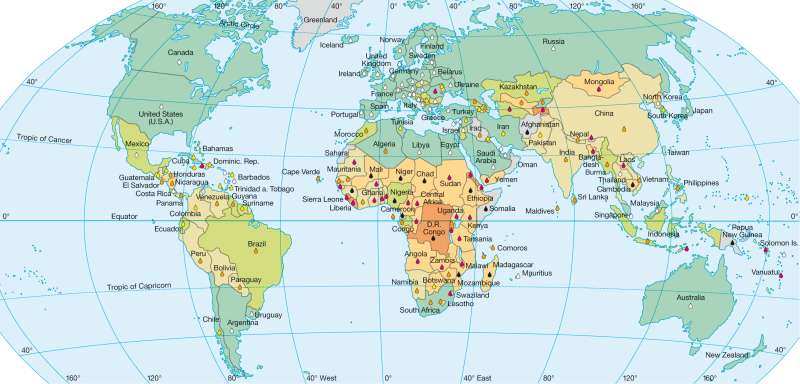Nutrition
The world - Level of development
978-3-14-100790-9 | Page 192 | Ill. 2

Information
The world food situation and access to clean drinking water was the theme of the World Development Report 2006 "Beyond Scarcity: Power, poverty and the global water crisis". Although the fight against extreme poverty and hunger, the "millennium development goals" for improving water supply has been given top priority by the United Nations. The situation has in recent years become rather worse. In 1995, there were approximately 790 million hungry people, by 2001, their numbers decreased slightly to 775 million, then rose again to 842 million in 2004. Most affected are women and children.Nutrition.
There are big differences between the different regions of the world. Sub-Saharan Africa, where there are the most least developed countries, is by far the most affected by hunger and poverty. The supply situation has deteriorated there in recent years and in some countries even more. In addition, a clean and safe water supply is hardly available anywhere there. There is a relatively safe food supply (except for North African countries) in South Africa, Nigeria, Equatorial Guinea and Gabon. Other countries such as Burundi, Mauritania, Kenya, Somalia, Niger and Rwanda are dependent on food imports.
There are few problems in Asian and Latin American countries, in comparison to those in large parts of Africa. A sub-group includes those with long-lasting civil wars, such as in Afghanistan and Haiti. There are, however, in both areas of the world, a large group of countries where there is only a relatively narrow upper and middle classes. There is a large majority of impoverished population that is permanently, quantitatively or qualitatively underserved.
Hunger and Malnutrition
Hunger is the result of complete food deprivation or a drastic reduction in food intake over long lasting periods of time. Those affected have a 20 percent or more lower supply of food than is the sufficient minimum quantity. Influence of age, physical fitness and work requirements affect the level of minimum energy required, which on average is 1800 to 2200 kcal or (7500 to 9200 kJ) per person, per day. These averages are typically used as an indicator but say nothing about the distribution and accessibility in a country.
If the requirements fall even slightly below the minimum, for a long length of time, we can speak of quantitative undernourishment. Food is more than energy intake. It also depends on the balanced supply of certain nutrients such as proteins, vitamins and minerals, which is often not guaranteed. In this case, there is "qualitative" malnutrition, a problem that frequently occurs in emerging markets.
A: M. Felsch, K. Heyden, Ü: Colette Fleming




